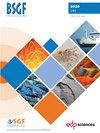Targeting and mapping expansive soils (Loiret, France): geometrical analysis of laboratory soil spectra in the short-wave infrared domain (1100–2500 nm)
IF 2.6
3区 地球科学
Q2 GEOSCIENCES, MULTIDISCIPLINARY
引用次数: 4
Abstract
Short-wave infrared (SWIR: 1100–2500 nm) reflectance spectra of soil samples, acquired under laboratory-controlled conditions, were used to estimate the swelling potentials of the soils and to use SWIR spectroscopy to improve a part of the swelling-risk map of France. A total of 332 samples were collected to the west of Orleans (France) in various geological formations and swelling-risk areas and along two (eastern and western) transects with different samples spacings. Comparisons between the swelling potentials of the soils and the swelling-risk areas of the map exhibit good correlation in the south of the sampling area; however, there are several inconsistencies in the north of the study area that highlight the necessity of locally redrawing the accepted swelling-risk map of France. The sampling interval (approximately 260 m) along the eastern transect was too sparse and does not appear to have effectively captured the smallest and/or isolated lithologies. The sampling interval along the western transect (approximately 50 m) revealed the presence of an unmapped swelling-potential zone, which was confirmed by several soil samples. The sample interval along the western transect appears to be more suitable for mapping the smallest lithologies. The presence of several samples in close proximity that exhibit the same swelling potential is a robust indication of the presence of a zone with constant swelling potential. A new swelling-risk map of the sampling area was produced based on the soil samples. The map produced by interpolation did not permit the representation of discrete lithological units, introduced spurious swelling-risk zones that however could be representative of tillage in agricultural zones. More samples are therefore needed to produce a reliable map on the scale of the sampling area. According to swelling potential uncertainty related to soil sampling and soil treatment, spectroscopy-based approach proposed here cannot be used to replace the existing swelling-risk map of France. This method permits however the rapid and low-cost estimation of the swell potentials of a large number of samples, which could be used at regional-scale to target areas where doubt remains or where infrastructure damages attributed to swelling behavior are known. At local scale, soil samples need to be properly and laboratory treated to accurately produce local revised and detailed swelling-risk maps.膨胀土定位与制图(法国卢瓦雷):实验室土壤光谱在短波红外域(1100-2500 nm)的几何分析
在实验室控制条件下获取土壤样品的短波红外(SWIR: 1100-2500 nm)反射光谱,用于估计土壤的膨胀势,并使用SWIR光谱对法国部分膨胀风险图进行改进。在法国奥尔良(Orleans)西部不同的地质构造和有膨胀风险的地区,沿着两个(东部和西部)不同采样间隔的样带,共收集了332个样本。在采样区南部,土壤的膨胀势与地图上的膨胀危险区之间的对比显示出良好的相关性;然而,在研究区域的北部有几个不一致的地方,这突出了在当地重新绘制法国公认的肿胀风险地图的必要性。东部样带的采样间隔(约260米)过于稀疏,似乎无法有效捕获最小和/或孤立的岩性。沿西部样带的采样间隔(约50 m)显示存在未绘制的膨胀电位区,这一点得到了几个土壤样品的证实。沿西部样带的采样间隔似乎更适合于绘制最小岩性。几个样品在近距离内表现出相同的膨胀电位,这是一个具有恒定膨胀电位的区域存在的有力指示。根据土壤样品绘制了新的样区膨胀风险图。通过插值生成的地图不允许表示离散的岩性单元,引入了虚假的膨胀风险区域,但这些区域可以代表农业区的耕作。因此,需要更多的样本,才能在采样地区的比例尺上绘制出可靠的地图。由于与土壤采样和土壤处理相关的溶胀潜在不确定性,本文提出的基于光谱的方法不能取代法国现有的溶胀风险图。然而,这种方法允许对大量样本的膨胀势进行快速和低成本的估计,这可以在区域尺度上用于仍然存在疑问的目标区域或已知肿胀行为导致的基础设施损坏的区域。在局部尺度上,需要对土壤样本进行适当的实验室处理,以准确地生成局部修订和详细的膨胀风险图。
本文章由计算机程序翻译,如有差异,请以英文原文为准。
求助全文
约1分钟内获得全文
求助全文
来源期刊
CiteScore
5.80
自引率
0.00%
发文量
18
审稿时长
>12 weeks
期刊介绍:
BSGF - Earth Sciences Bulletin publie plusieurs types de contributions :
1. des articles originaux, couvrant tous les champs disciplinaires des Géosciences, à vocation fondamentale mais également à vocation plus appliquée (risques, ressources);
2. des articles de synthèse, faisant le point sur les avancées dans un domaine spécifique des Géosciences, qu''elles soient méthodologiques ou régionales ;
3. des monographies sur la géologie d’une région donnée, assorties d’informations supplémentaires, cartes, coupes, logs, profils sismiques … publiées en ligne en annexe de l’article ;
4. des articles courts de type « express letter » ;
5. des livrets-guides d’excursion (qui suivront le même processus d’examen éditorial que les articles plus classiques) ;
6. des comptes rendus de campagnes à la mer ;
7. des articles de données géodésiques, géophysiques ou géochimiques, pouvant devenir des articles de référence pouvant conduire à des interprétations ultérieures.
BSGF - Earth Sciences Bulletin constitue également un forum pour les discussions entre spécialistes des Sciences de la Terre, de type comment-reply ou autre. Tous les articles publiés, quelle que soit leur forme, seront accessibles sans frais (articles en Open Access) sur le site de la SGF et sur celui de Geosciences World dans la mesure où les auteurs se seront acquittés d’une contribution de (Article Processing Charges – APC) de 300€ pour les membres de la SGF et 500€ pour les non-membres.

 求助内容:
求助内容: 应助结果提醒方式:
应助结果提醒方式:


